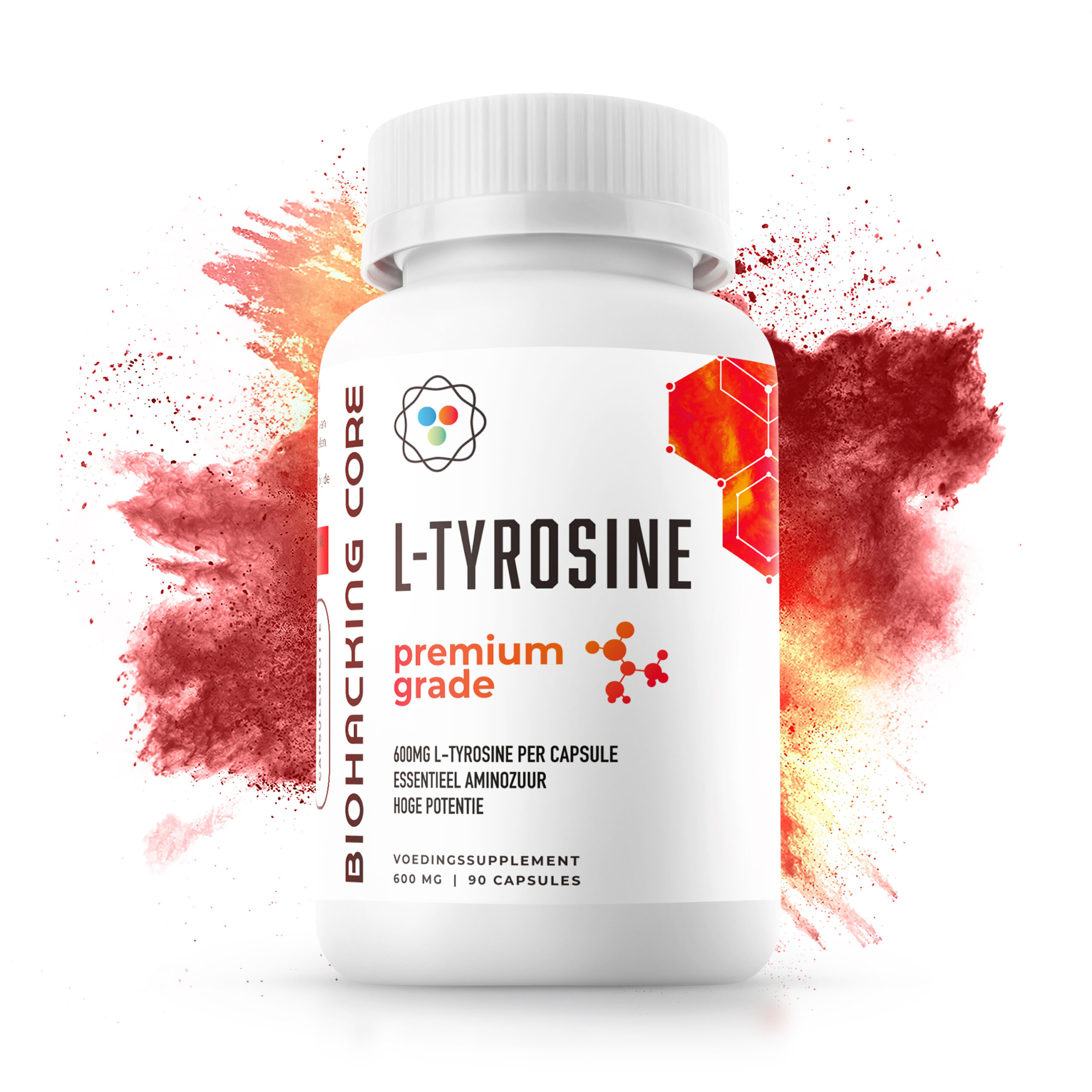

L-Tyrosine – 90c.
- Category: Amino acids
Form
Quantity
| Quantity | Discounted price | DISCOUNT |
|---|---|---|
| 3-5 | €15.53 | 5%€0.82 |
| 6-9 | €15.04 | 8%€1.31 |
| 10+ | €14.71 | 10%€1.64 |
Change your country
- Your Biohacking Experts.
- Mo-Fr Same day shipping for orders before 17:00.
- Free shipping for orders above 50eu.
- Superior Quality high purity extracts and compunds.
- Quantity based discounts applicable.
Biohacking Core L-Tyrosine (Capsules & Powder)
Product Overview
Biohacking Core L-Tyrosine is available in both encapsulated and powder forms, providing a pure, reliable source of the amino acid L-Tyrosine. Sourced from certified facilities, this supplement offers consistent quality and verified purity in every serving. While L-Tyrosine is naturally present in high-protein foods, supplementation offers a controlled and measurable option for intake.
Key Features
- 600 mg per capsule or 1000 mg per powder serving.
- Available in encapsulated or 100% pure powder form.
- Purity tested and confirmed at ≥98.5%.
- Manufactured under ISO 9001 and ISO 22000 certified systems.
- Capsules use only minimal pharmaceutical-grade flow agents.
- No fillers, flavors, or unnecessary additives in powder format.
Ingredients & Supplement Facts
Capsule Form:
- Serving Size: 1 capsule
- Servings Per Container: 90
- Amount Per Serving:
- L-Tyrosine: 600 mg
- Other Ingredients: Gelatin (capsule shell), Microcrystalline Cellulose.
Powder Form:
- Serving Size: 1 gram (1 scoop included)
- Servings Per Container: Approx. 100 (based on 100 g pouch)
- Amount Per Serving:
- L-Tyrosine: 1000 mg
- Other Ingredients: None.
Suggested Use
- Capsules: 1 capsule daily*
- Powder: 1–2 scoops daily*
Quality You Can Trust
Biohacking Core L-Tyrosine is produced under certified ISO 9001 and ISO 22000 systems, ensuring high manufacturing integrity and consistency. Each batch is tested to confirm ≥98.5% purity. Our powder form is 100% unadulterated L-Tyrosine, and the capsules contain only the active ingredient with minimal processing agents to preserve form and function.
Packaging & Storage
- Capsules: 90 capsules per plastic bottle.
- Powder: 100 g in resealable pouch.
- Storage: Store in a cool, dry place. Keep containers sealed after each use. Keep out of reach of children.
Warnings & Cautions
- For adult use only.
- Consult your healthcare provider before use if pregnant, nursing, taking medications (especially MAO inhibitors or thyroid medications), or if you have a medical condition (e.g., high blood pressure, melanoma, or PKU).
- Discontinue use and seek medical advice if adverse reactions occur.
Disclaimer
This product is a dietary supplement and is not intended to diagnose, treat, cure, or prevent any disease. This product is NOT medicinal, it is NOT a form of prescription or over-the-counter medication. This product should not replace a balanced diet or healthy lifestyle, it is not a replacement for any medicine or treatment for any health issues. Do not exceed the recommended daily dose. Always consult a medical or dietary professional before making changes to your nutrition. Follow the details on the label.
Latest Blogs
Stay Informed, Stay Ahead: Discover the Latest Insights in Biohacking

Designing Your Morning: Simple Practices to Start Your Day Intentionally
Mornings set the tone for the rest of your day. Yet, many of us start on autopilot—hitting snooze, gulping coffee,...
Read More
Mindful Breathing: Simple Techniques for Pausing and Centering
In the rush of daily life, it’s easy to get caught up in stress and lose our sense of balance....
Read More
Connecting with Nature: Incorporating Outdoor Time into Your Routine
Modern lifestyles often keep us indoors in climate-controlled homes and offices. In fact, people today spend around 90% of their...
Read More
Understanding Eating Schedules: An Introduction to Time-Restricted Eating Patterns
Imagine only eating during certain hours each day and giving your body a rest for the remaining time. This concept...
Read More
Exploring Cold Water Exposure: Understanding the Practice of Cold Showers
Cold water exposure – especially cold showers – has surged in popularity as a wellness trend in recent years. From...
Read More
Vitamin C & Brain Health: Optimize Your Intake
Like most, you’ve probably sought the assistance of compounds to optimize your cognition and brain health. Maybe you struggle with...
Read More
Level Up: Unearth Our Unsurpassed Quality!
CONTACT

0 reviews
Only logged in customers who have purchased this product may leave a review.